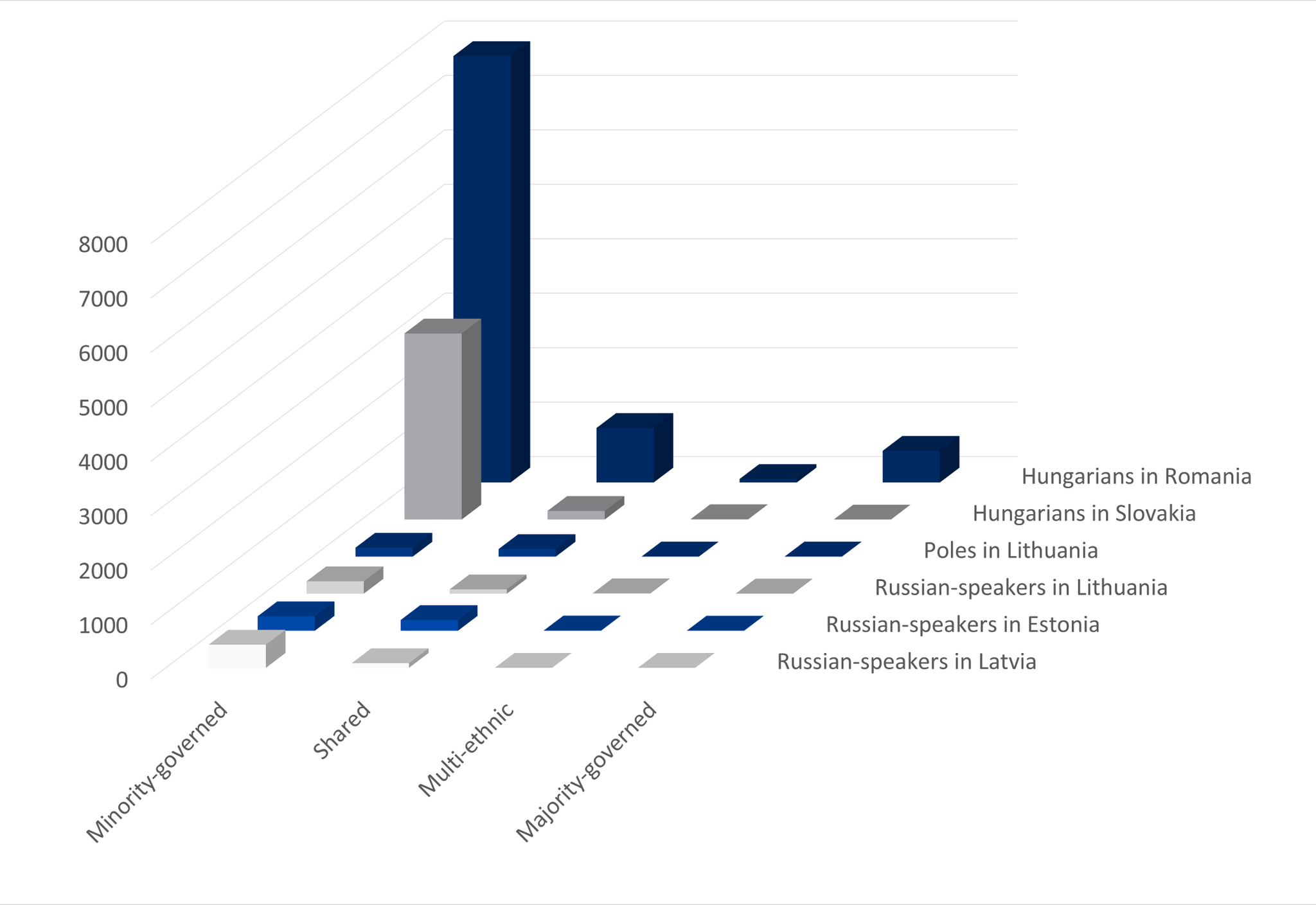Minority institutions are classified according to their structure of self-governance:
Structures governing minority institutions constitute another determinant of minority access to decision-making. We distinguish between four types of organizations - minority-governed, shared, multiethnic, and majority-governed (or mainstream) organizations.
- Minority-governed organizations are controlled by minority actors, and the minority ethnic category (e.g., language, religious rules and customs, etc.) is unmarked (default) in their main activities. Minority-governed institutions do not have to be “ethnic” in their purpose or goals. For instance, a sports club governed and populated mostly by minority actors in which minority ethnic markers are unmarked (e.g., the minority language is the default) is minority-governed even if its constitutive act does not explicitly feature ethnic character. These organizations play a significant role in creating bonding social capital and can also participate in interethnic bridging activities.
- Shared organizations are not typically governed by ethnic minorities (though they may be, in some instances, where the minority comprises a local majority), but they recognize and provide space for ethnic minority members. In these organizations, there are typically subdivisions/streams/programs designed for minority members, which are identifiable inside the organization. A typical example is a school with a separate majority and minority streams/programs of study.
- Multiethnic organizations are designed to advance ethnic parity and interethnic cooperation. Both majority and minority users are present, ethnicity is recognized, but no specific substructures, administrative routes, or programs are designed for majority and minority users. Rather, cultural rules are flexible and informal. Examples are multiethnic/bilingual political parties, theatres, churches, or schools aiming actively for parity among ethnicities. Multiethnic institutions actively promote parity among ethnicities and play an important role in bridging and developing interethnic trust.
- Majority-governed (mainstream) organizations. In majoritarian nation-states, not only public institutions but also the vast majority of voluntary associations are majority-governed. There is no specific recognition of ethnic minority presence in such associations, and relationships within the organization replicate ethnic relations characteristic of the larger society. There is no specific recognition of ethnic minority presence, and relationships within the organization replicate ethnic relations characteristic of the larger society. These organizations typically exist in all institutional domains (local government, education, religion, culture, etc.) and operate according to the cultural norms of the majority/mainstream.
Overall Data
Minority-governed institutions form the most numerous structures of self-governance. However, there is also some variation in terms of the most dominant type of organizations. In case of Poles in Lithuania and Russians in Estonia, over 98% of institutions are split close to equally between minority-dominated (53.6% and 56.6%) and shared (45.1% and 42.1%) organizations.

This table presents the structures of self-governance minorities maintain in selected majoritarian states. The links in the table will lead to case-specific description and visualizations.
| Minority groups | Total | Structure of self-governance | |||
|---|---|---|---|---|---|
| Minority-Governed | Shared | Multi-Ethnic | Majority-governed | ||
| Romanian Hungarians | 9477 | 7832 | 1000 | 64 | 581 |
| Hungarians in Slovakia | 3582 | 3417 | 158 | 7 | 0 |
| Poles in Lithuania | 306 | 164 | 138 | 2 | 2 |
| Russian speakers in Lithuania | 320 | 240 | 71 | 7 | 2 |
| Russian speakers in Estonia | 468 | 265 | 197 | 4 | 2 |
| Russian speakers in Latvia | 511 | 425 | 86 | 0 | 0 |
This table presents the proportion of structures of self-governance for each group. The links in the table will lead to case-specific description and visualizations.
| Minority groups | Structure of self-governance | |||
|---|---|---|---|---|
| Minority-Governed | Shared | Multi-Ethnic | Majority-governed | |
| Hungarians in Romania | 83% | 11% | 1% | 6% |
| Hungarians in Slovakia | 95% | 4% | 0% | 0% |
| Poles in Lithuania | 54% | 45% | 1% | 1% |
| Russian speakers in Lithuania | 75% | 22% | 2% | 1% |
| Russian speakers in Estonia | 57% | 42% | 1% | 0% |
| Russian speakers in Latvia | 83% | 17% | 0% | 0% |
Structure of self-governance of minority organization data by minority group and country
Select a country to view case-level data on the structure of self-governance of minority institutions:
| Russian speakers | Hungarians | Poles | Turks | Albanians |
|---|---|---|---|---|
| Estonia | Romania | Lithuania P | Bulgaria | North Macedonia |
| Latvia | Slovakia | |||
| Lithuania R | Serbia |